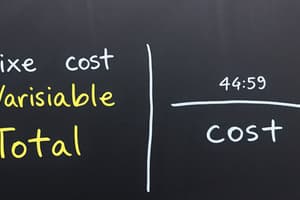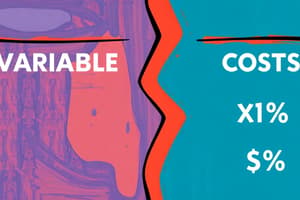Podcast
Questions and Answers
A firm's ___________ consist of expenditures that must be made before production starts that typically, over the short run, _______________ regardless of the level of production.
A firm's ___________ consist of expenditures that must be made before production starts that typically, over the short run, _______________ regardless of the level of production.
fixed costs; do not change
______________ include all of the costs of production that increase with the quantity produced.
______________ include all of the costs of production that increase with the quantity produced.
Variable costs
____________________________ occur when the marginal gain in output diminishes as each additional unit of input is added.
____________________________ occur when the marginal gain in output diminishes as each additional unit of input is added.
Diminishing marginal returns
In order to determine ____________, the firm's total costs must be divided by the quantity of its output.
In order to determine ____________, the firm's total costs must be divided by the quantity of its output.
In order to determine the average variable cost, the firm's variable costs are divided by __________.
In order to determine the average variable cost, the firm's variable costs are divided by __________.
The term _____________ is used to describe the additional cost of producing one more unit.
The term _____________ is used to describe the additional cost of producing one more unit.
The term __________________ describes a situation where the quantity of output rises, but the average cost of production falls.
The term __________________ describes a situation where the quantity of output rises, but the average cost of production falls.
In microeconomics, the term _____________________ is synonymous with economies of scale.
In microeconomics, the term _____________________ is synonymous with economies of scale.
The term 'constant returns to scale' describes a situation where __________.
The term 'constant returns to scale' describes a situation where __________.
If a firm is experiencing _____________________, then as the quantity of output rises, the average cost of production rises.
If a firm is experiencing _____________________, then as the quantity of output rises, the average cost of production rises.
___________ include all spending on labor, machinery, tools, and supplies purchased from other firms.
___________ include all spending on labor, machinery, tools, and supplies purchased from other firms.
If a solar panel manufacturer wants to look at its total costs of production in the short run, what would provide a useful starting point?
If a solar panel manufacturer wants to look at its total costs of production in the short run, what would provide a useful starting point?
All but one of the following can be classified as a variable cost arising from the physical inputs Marcella requires to operate her business. Which is it?
All but one of the following can be classified as a variable cost arising from the physical inputs Marcella requires to operate her business. Which is it?
Why would labor be treated as a variable cost?
Why would labor be treated as a variable cost?
If a paper mill shuts down its operations for three months so that it produces nothing, what will be reduced to zero?
If a paper mill shuts down its operations for three months so that it produces nothing, what will be reduced to zero?
Fixed costs are important because, at least in the ___________, the firm _______________.
Fixed costs are important because, at least in the ___________, the firm _______________.
In order to calculate marginal cost, the change in ______________ is divided by the amount of change in quantity.
In order to calculate marginal cost, the change in ______________ is divided by the amount of change in quantity.
What does the price elasticity of demand measure?
What does the price elasticity of demand measure?
Price elasticity of demand is defined as:
Price elasticity of demand is defined as:
Demand is said to be ___________ when the quantity demanded is very responsive to changes in price.
Demand is said to be ___________ when the quantity demanded is very responsive to changes in price.
Demand is said to be _____________ when the quantity demanded is not very responsive to changes in price.
Demand is said to be _____________ when the quantity demanded is not very responsive to changes in price.
The elasticity of demand is defined as the percentage change in quantity demanded divided by the percentage change in __________.
The elasticity of demand is defined as the percentage change in quantity demanded divided by the percentage change in __________.
When demand is inelastic, what does that mean?
When demand is inelastic, what does that mean?
A price cut will increase the total revenue a firm receives if the demand for its product is:
A price cut will increase the total revenue a firm receives if the demand for its product is:
The longer the time period considered, how does the elasticity of supply tend to change?
The longer the time period considered, how does the elasticity of supply tend to change?
Taxes on goods with __________ demand curves will tend to raise more tax revenue for the government than taxes on goods with __________ demand curves.
Taxes on goods with __________ demand curves will tend to raise more tax revenue for the government than taxes on goods with __________ demand curves.
What is the elasticity formula?
What is the elasticity formula?
An elastic demand curve is characterized by a:
An elastic demand curve is characterized by a:
An inelastic demand curve is characterized by a:
An inelastic demand curve is characterized by a:
Total Revenue Formula:
Total Revenue Formula:
Income Elasticity of Demand Formula:
Income Elasticity of Demand Formula:
Average Total Cost (ATC) formula:
Average Total Cost (ATC) formula:
Average Variable Cost (AVC) formula:
Average Variable Cost (AVC) formula:
Average Fixed Cost (AFC) formula:
Average Fixed Cost (AFC) formula:
Increasing returns to scale is defined as:
Increasing returns to scale is defined as:
The law of diminishing marginal utility states:
The law of diminishing marginal utility states:
Three factors of decision making include:
Three factors of decision making include:
The law of diminishing returns states:
The law of diminishing returns states:
The marginal product of labor is defined as:
The marginal product of labor is defined as:
Marginal cost formula:
Marginal cost formula:
Total Cost Formula:
Total Cost Formula:
Fixed Cost Formula:
Fixed Cost Formula:
Variable Cost Formula:
Variable Cost Formula:
Characteristics of Perfect Competition include:
Characteristics of Perfect Competition include:
Why in the long run are there zero profits in a perfect competition market?
Why in the long run are there zero profits in a perfect competition market?
Flashcards are hidden until you start studying
Study Notes
Costs in Production
- Fixed costs must be incurred before production begins and remain unchanged in the short run, irrespective of output levels.
- Variable costs increase with the quantity produced, directly affecting total production costs.
- Average costs are calculated by dividing total costs by the quantity of output.
- Average variable cost is determined by dividing total variable costs by the quantity produced.
Marginal Costs and Returns
- Marginal cost refers to the additional cost associated with producing one more unit of output.
- Diminishing marginal returns occur when adding more input results in a smaller increase in output.
- Economies of scale refer to the reduction in average production costs as output increases.
- Constant returns to scale mean that output expansion does not affect average production costs.
- Decreasing returns to scale indicates that increased output raises average production costs.
Revenue and Demand Elasticity
- Price elasticity of demand measures how responsive the quantity demanded is to price changes, calculated as the percentage change in quantity divided by the percentage change in price.
- Demand is elastic if it significantly responds to price changes and inelastic if it is relatively unresponsive.
- Total revenue increases with a price cut if the demand for the product is elastic.
- Over time, the elasticity of supply tends to increase due to the adaptability of producers.
Tax Revenue and Elasticity
- Taxes on goods with elastic demand yield less revenue compared to taxes on goods with inelastic demand due to varying responsiveness to price changes.
Formulas and Concepts
- Total Revenue is calculated as P (price) multiplied by Q (quantity).
- Various cost and elasticity formulas include:
- Average Total Cost (ATC): Total Costs (TC) divided by Quantity (Q).
- Average Variable Cost (AVC): Variable Costs (VC) divided by Quantity (Q).
- Marginal Cost: Change in Total Cost (TC) divided by change in Quantity (Q).
- Total Cost (TC): Fixed Costs (FC) plus Variable Costs (VC).
Perfect Competition Characteristics
- A perfectly competitive market has many buyers and sellers, homogeneous products, and free entry and exit for firms.
- Long-run profits in a perfectly competitive market tend toward zero due to the influx of firms producing similar products, leading to thin margins as supply increases.
Utility and Decision-Making
- The law of diminishing marginal utility states that additional units of a good yield less satisfaction over time.
- Decision making can be impaired by ignoring opportunity costs, sunk costs, and unrealistic expectations about future behavior.
- The law of diminishing returns indicates that adding more of a variable input will eventually lead to decreased marginal output.
Studying That Suits You
Use AI to generate personalized quizzes and flashcards to suit your learning preferences.




